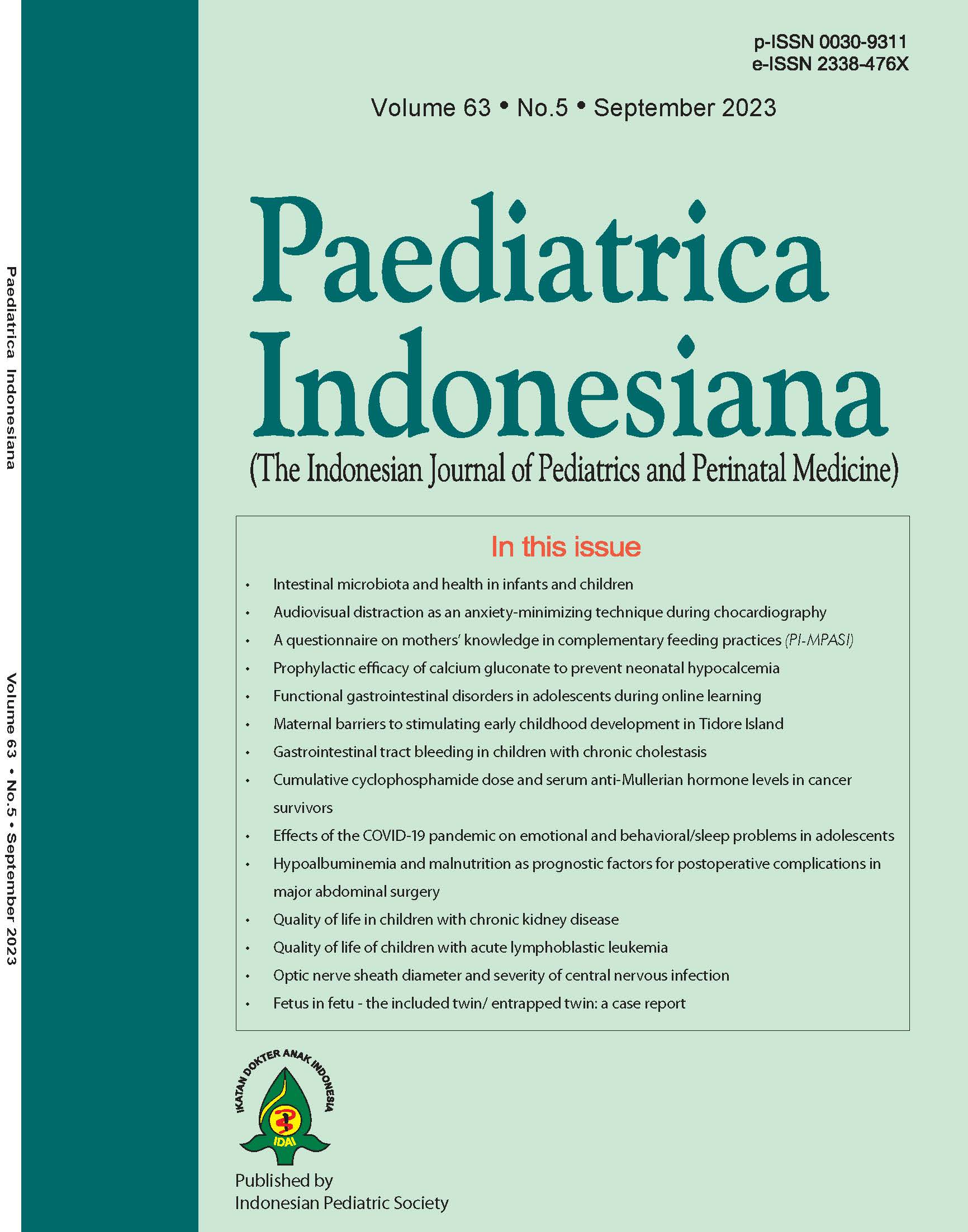Gastrointestinal tract bleeding in children with chronic cholestasis: Prevalence and risk factors in a tertiary referral hospital in Indonesia
DOI:
https://doi.org/10.14238/pi63.5.2023.370-5Keywords:
Prevalence, Risk Factors, Cholestasis, Hemorrhage, Child, Tertiary Care CentersAbstract
Background Cholestasis can lead to several complications, including portal hypertension and risk of gastrointestinal bleeding. However, there is a paucity of studies on the risk factors and prevalence of gastrointestinal tract bleeding in children with chronic cholestasis, particularly in Indonesia.
Objective To determine the prevalence and risk factors for gastrointestinal bleeding in children with chronic cholestasis in Cipto Mangunkusumo Hospital, Jakarta, Indonesia.
Methods This was a retrospective cohort study in a national referral hospital in Indonesia. Medical records of children with chronic cholestasis who visited the gastroenterohepatology outpatient clinic were collected for five years. Data on clinical symptoms, etiologies, and complications were obtained.
Results A total of 97 participants were recruited on this study. The median age of the group was 0.31 years old. The most common causes of chornic cholestasis were biliary atresia, toxoplasma, other infections, rubella, cytomegalovirus, and herpes simplex virus (TORCH) infection, and urinary tract infection. Gastrointestinal bleeding occurred in 27.8% of patients, with hematemesis-melena being the most prevalent symptom. We found that liver cirrhosis, splenomegaly, thrombocytopenia, portal hypertension, and esophageal varices were all highly related with gastrointestinal bleeding. Splenomegaly, thrombocytopenia, and esophageal varices were associated with an increased risk of gastrointestinal bleeding in children with chronic cholestasis (P=0.018, P=0.008, and P=0.039, respectively).
Conclusions The prevalence of gastrointestinal tract bleeding in children with chronic cholestasis is 27.8%, with splenomegaly, thrombocytopenia, and esophageal varices as significant risk factors.
References
2. Kriegermeier A, Green R. Pediatric cholestatic liver disease: Review of bile acid metabolism and discussion of current and emerging therapies. Front Med (Lausanne). 2020;7:149. DOI: https://doi.org/10.3389/fmed.2020.00149.
3. Feldman AG, Sokol RJ. Recent developments in diagnostics and treatment of neonatal cholestasis. Seminars in pediatric surgery; 2020: Elsevier.
4. Kusumawati NR, Ritonga RS, Kevin C, Sulaiman S, Siahaan SS, Pratiwi J. Demographic characteristics of children with biliary atresia in dr. Kariadi General Hospital, Semarang. Arch Pediatr Gastroenterol Hepatol Nutr. 2022;1:1-7. DOI: https://doi.org/10.58427/apghn.1.2.2022.1-7.
5. Tomarchio S, Pietrobattista A, Candusso M, Basso M, Liccardo D, Grimaldi C, et al. Gastrointestinal bleeding in children with biliary atresia. Digestive Liver Dis. 2016;48:e259. DOI: https://doi.org/10.1016/j.dld.2016.08.049.
6. Jain M, Adkar S, Waghmare C, Jain J, Jain S, Jain K, et al. Neonatal cholestasis - single centre experience in Central India. Indian J Community Med. 2016;41:299-301. DOI: https://doi.org/10.4103/0970-0218.193331.
7. Choi HJ, Kim I, Lee HJ, Oh HJ, Ahn MK, Baek WI, et al. Clinical characteristics of neonatal cholestasis in a tertiary hospital and the development of a novel prediction model for mortality. EBioMedicine. 2022;77:103890. DOI: doi.org/10.1016/j.ebiom.2022.103890.
8. Lee KJ, Kim JW, Moon JS, Ko JS. Epidemiology of biliary atresia in Korea. J Korean Med Sci. 2017;32:656-60. DOI: https://doi.org/10.3346/jkms.2017.32.4.656.
9. Hoerning A, Raub S, Dechêne A, Brosch MN, Kathemann S, Hoyer PF, et al. Diversity of disorders causing neonatal cholestasis–the experience of a tertiary pediatric center in Germany. Frontiers in Pediatrics. 2014;2:65. DOI: https://doi.org/ 10.3389/fped.2014.00065.
10. Angelico R, Pietrobattista A, Candusso M, Tomarchio S, Pellicciaro M, Liccardo D, et al. Primary prophylaxis for gastrointestinal bleeding in children with biliary atresia and portal hypertension candidates for liver transplantation: A single-center experience. Transplant Proc. 2019;51:171-8. DOI: https://doi.org/10.1016/j.transproceed.2018.04.074.
11. Polat E, Bayrak NA, Kutluk G, Civan HA. Pediatric upper gastrointestinal bleeding in children: etiology and treatment approaches. J Emerg Pract Trauma. 2020;6:59-62. DOI: https://doi.org/10.34172/jept.2020.10.
12. Jafari SA, Kiani MA, Kianifar HR, Mansooripour M, Heidari E, Khalesi M. Etiology of gastrointestinal bleeding in children referred to pediatric wards of Mashhad hospitals, Iran. Electron Physician. 2018;10:6341-5. DOI: https://doi.org/10.19082/6341.
13. Gultekingil A, Teksam O, Gulsen HH, Ates BB, Salt?k-Temizel ? N, Demir H. Risk factors associated with clinically significant gastrointestinal bleeding in pediatric ED. Am J Emerg Med. 2018;36:665-8. DOI: https://doi.org/10.1016/j.ajem.2017.12.022.
14. Haghbin S, Manafi Anari A, Serati Z, Aflaki K, Haghighi Aski B, Navaei Far MR. Incidence and risk factors of upper gastrointestinal bleeding in pediatric intensive care unit admitted patients. Int J Child Adolesc. 2016;2:11-6.
15. Scharf RE. Thrombocytopenia and hemostatic changes in acute and chronic liver disease: Pathophysiology, clinical and laboratory features, and management. J Clin Med. 2021;10:1530. DOI: https://doi.org/10.3390/jcm10071530.
16. Gallo P, Terracciani F, Di Pasquale G, Esposito M, Picardi A, Vespasiani-Gentilucci U. Thrombocytopenia in chronic liver disease: Physiopathology and new therapeutic strategies before invasive procedures. World J Gastroenterol. 2022;28:4061-74. DOI: https://doi.org/10.3748/wjg.v28.i30.4061.
17. Desai S, Subramanian A. Thrombocytopenia in chronic liver disease: challenges and treatment strategies. Cureus. 2021;13:e16342. DOI: https://doi.org/10.7759/cureus.16342.
18. Li L, Duan M, Chen W, Jiang A, Li X, Yang J, et al. The spleen in liver cirrhosis: revisiting an old enemy with novel targets. J of Transl Med. 2017;15:111. DOI: https://doi.org/10.1186/s12967-017-1214-8.
19. Meseeha M, Attia M. Esophageal Varices: Treasure Island (FL): StatPearls Publishing. [cited 2023 July 8]. Available from: https://www.ncbi.nlm.nih.gov/books/NBK448078/.
Downloads
Published
How to Cite
Issue
Section
License
Authors who publish with this journal agree to the following terms:
Authors retain copyright and grant the journal right of first publication with the work simultaneously licensed under a Creative Commons Attribution License that allows others to share the work with an acknowledgement of the work's authorship and initial publication in this journal.
Authors are able to enter into separate, additional contractual arrangements for the non-exclusive distribution of the journal's published version of the work (e.g., post it to an institutional repository or publish it in a book), with an acknowledgement of its initial publication in this journal.
Accepted 2023-10-23
Published 2023-10-23


















